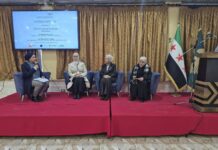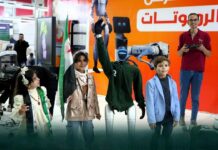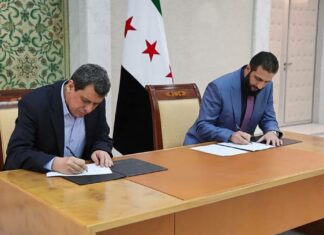
By, Ibrahim Harun
Residents of Qaqfin gathered what remained of the children picking olives, the bodies wrapped under a white tarp, arranged in rows. The November 25th scene of the aftermath of yet another indiscriminate shelling by the Syrian military is a continuation of a string of alarming escalations in Northwestern Syria. The Assad regime has persisted in flagrant violations of the March 2020 truce throughout the years, but the relentless aggression in recent months signals the engineering of a wintry humanitarian catastrophe.
A False Peace
Syrian civilians in cities and residential areas are routinely subjected to sporadic shelling by regime forces, a reality that largely fails to muster any significant international comment. The Syrian Network for Human Rights (SNHR) reports 74 attacks by the Syrian regime in October alone. Among the essential civilian structures targeted in these attacks were 13 places of worship, as well as 27 educational and 11 medical facilities, most of which were centered in the governorates of Idlib and Aleppo.
The construct of a stable Assad government and a subdued war remains the international standard, a fiction inconvenienced by reports of hundreds massacred on a monthly basis, reports which have barely blipped across the news wire. The Syrian Observatory for Human Rights (SOHR) estimates 113 civilian deaths in September, 238 in October, and a death toll of over 300 so far in November. However, this lack of will to convey the ongoing complexities in the northern province of Idlib is not an accidental oversight; rather it is a collective and conscious omission reflective of larger agendas.

The Arab push toward normalization of relations with the Syrian regime was primarily motivated at stabilizing regional economics, containing possible security threats, stemming the flow of refugees, and addressing Assad’s problematic operations as a lucrative narco-state. Similarly, Europe’s right-leaning governments and Turkey are served by a willful denial of conditions in Syria to support xenophobic domestic policies rejecting refugees.
Facing negligible scrutiny, international actors hold no accountability for their participation in the ongoing violence and have acted with relative impunity, whether they be associated with the Syrian regime’s employment of private militias, or the myriad of foreign actors operating within Syria: Iranian, Russian, Turkish, and especially the US-backed Kurdish-led Syrian Democratic Forces (SDF), who, after the regime itself, have consistently been, by far, the worst perpetrators of civilian casualties and human rights violations.
Local Journalists Identify the Challenges
Twelve years on, the Syrian struggle is in even more desperate need of accurate coverage. “The journalist’s role here is very significant because it is about conveying the voice of the people in the region to the world, showing their pains, aspirations, and dreams,” reminds Amer Assi, a local journalist. “The most important thing is to convey their voice for freedom and overthrowing the regime that many media outlets have tried to silence and divert attention from.”
When not entirely ignored, coverage of the region often waves the specter of global jihad, leading many journalists to bemoan the absence of a true portrayal of the Syrian struggle. Mahmood Musa, a local media activist, describes the dilemma: “We can say that global media is divided into two streams: an external stream that portrays liberated areas with the label of terrorism and chaos, and a stream that manages to enter the liberated areas to convey the true image.”
International media, Musa says, compromises its accuracy by relying on questionable sources that exploit the external demand to demonize governance in liberated territories.
In May 2022, Azerbaijani journalist, Vafa Agabalayeva, was granted access to the Idlib region for what was supposedly a documentary. When Azerbaijani television aired the fabricated and sensationalized piece, Abdullah Ismail, a field coordinator in Idlib Center for Media Services (ICMS), could not believe the horror. “Basically, the Syrian people are shamelessly accused of having a propensity for terrorism.”
Similarly, in August of this year, Al-Monitor published an article by Essam Sabry Hafez claiming the territory was rife with various human rights violations including human trafficking and a purported ‘slave market.’ Days later the Saudi-based media outlet issued a retraction because they could not “verify the accuracy of certain elements in the story.”
The simultaneously abhorrent and standard operating procedures of agenda-driven reporting is not limited to Syria. In fact, blatant examples of racist biases are amplified in the daily and desperate public relations fiascos of the Occupying force in Gaza.
In one such incidence in early December, The Jerusalem Post claimed that a viral post of a man grieving for a dead child featured a baby doll.

“There’s no way I can possibly describe the complete and utter dehumanization of the Palestinian people,” commented Palestinian journalist, Hebh Jamal.
The fictitious and inflammatory allegations were later retracted, but its circulation revealed the deliberate way in which international media irresponsibly dispenses chilling villainizations of civilians suffering on the front lines.
This dehumanization permeates most of the coverage of the region, reinforcing a particularly violent political narrative. The cost of this reframing, unfortunately, is paid for in Palestinian and Syrian lives.
Humanitarian Consequences
In a 2018 Daedalus essay, Lyse Doucat examined the effect of media coverage on US policy in the early years of the Syrian conflict. For better or worse, intense media coverage “kept the issue on policy-makers’ desks…what media scholars refer to as ‘agenda setting’ or an ‘accelerating effect.’” The result was another costly and ineffective US entanglement in the region that persists until today.
Conversely, preponderance of media exposure can potentially bring positive relief to civilians. Coverage of the recent bombardment of Gaza effectively pressured the US into negotiating a ceasefire and allowing a minuscule amount of aid into the devastated territory.
Yet, despite its ability to bring pressing issues to the forefront, journalists warn that simplified exposure of complex conflicts can result in curated coverage with deadly consequences.
“Idlib is a textbook case of how media bias could have significant human cost,” cautions Dareen Khalifa, Senior Advisor for the International Crisis Group. “For years most Western media as well as many think-tanks only looked at Idlib from a CT (counter terrorism) prism. They painted the region as the ‘biggest’ al-Qaeda controlled enclave and completely disregarded the fate of millions of civilians let alone any nuance around the transformation of Islamist groups controlling the province.”

“This not only gave an additional pretext to Russia to indiscriminately attack the area but also led many Western donors to pull back their support to basic services like health and education cutting a lifeline to millions of Syrians.”
Khalifa’s criticisms can hardly be discounted. This year’s earthquake damage coupled with the regime’s targeting of critical infrastructure, Syrians, especially those in the North, are facing an increased threat to clean water supplies. The recent escalations by the regime include targeting of farms and popular markets, further disrupting access to a consistent food supply in an already destabilized market. The aggression is also pushing new refugees into a region already overwhelmed by IDPs.
With nothing to keep him in check, Assad is expected to further intensify his assault on the North and other areas in the approach to, what may be, a harsh winter. Dishonest and disingenuous media may not view itself as complicit, but its policy has a tangible humanitarian cost, the quantifiable effect observable in ubiquitous, white body bags.








